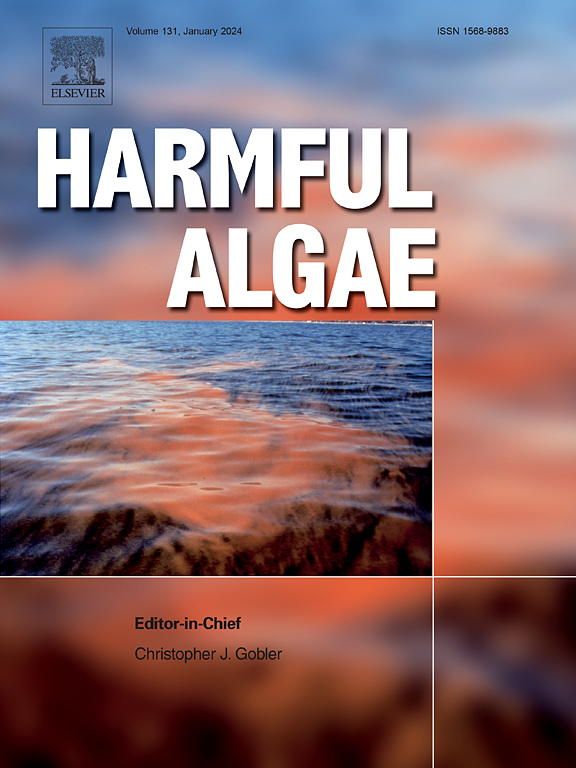Mixotrophic flagellate Ochromonas gloeopara promotes heterocyst production in cyanobacteria with altered filament length
IF 4.5
1区 生物学
Q1 MARINE & FRESHWATER BIOLOGY
引用次数: 0
Abstract
Heterocystous cyanobacteria can adapt to environmental fluctuations typically via the production of heterocyst, a specialized cell functioning dinitrogen-fixing. Responses of heterocyst production to abiotic stressors like nutrient availability have been widely studied. In natural environments cyanobacteria also face great pressures from a variety of organisms including mixotrophic protists. However, little is known about the impacts of mixotrophic protists on the filamentous cyanobacteria characterized by heterocyst production. Here, we explored the grazing of the flagellate Ochromonas gloeopara on two heterocystous cyanobacteria Dolichospermum flos-aquae and Anabaena sp., together with the cyanobacterial responses in terms of population growth, heterocyst production, filament length and photosynthesis. Results showed that O. gloeopara preyed on short filaments of both cyanobacteria, reducing the population growth rate of D. flos-aquae but not the Anabaena sp. The average filament length of the two species was generally increased by O. gloeopara grazing at the initial cultivation, whereas reversed phenomenon was observed in Anabaena sp. at late cultivation. O. gloeopara presence promoted the heterocyst production in both the cyanobacteria, with heterocyst abundance showing a rapid increase followed by decrease dynamic with cultivation. Heterocyst placement pattern was also changed with the number of vegetative cells between heterocysts increased in Anabaena sp. At the peak phase of heterocyst production, the maximum quantum efficiency of photosynthesis in D. flos-aquae enhanced as response to O. gloeopara presence. These findings reveal a phenotypic adaptation of heterocystous cyanobacteria to pressures from mixotrophic protists, providing a new perspective for understanding the role of biotic interactions in cyanobacterial blooms.
混合营养鞭毛藻Ochromonas gloeopara在改变纤维长度的蓝藻中促进异囊的产生
异囊蓝藻通常通过产生异囊来适应环境波动,异囊是一种特殊的细胞,具有固定二氮的功能。杂种囊的产生对营养可利用性等非生物胁迫的响应已被广泛研究。在自然环境中,蓝藻也面临着来自各种生物的巨大压力,包括混合营养原生生物。然而,混合营养原生生物对以异囊产生为特征的丝状蓝藻的影响知之甚少。本研究探讨了鞭藻Ochromonas gloeopara对两种异囊蓝藻Dolichospermum flos-aquae和Anabaena sp.的放牧,以及蓝藻对种群生长、异囊产生、丝长和光合作用的响应。结果表明,绿僵菌对两种蓝藻的短丝均有捕食作用,对水藻种群的生长速率均有影响,对水藻种群的生长速率无影响。绿僵菌在养殖初期的平均丝长均有增加,而在养殖后期的平均丝长则相反。O. gloeopara的存在促进了这两种蓝藻的杂泡产生,随着培养,杂泡丰度呈先增加后减少的动态变化。杂囊的放置模式也随着杂囊间营养细胞数量的增加而改变。在杂囊产生的高峰期,水藻光合作用的最大量子效率随着水藻的存在而提高。这些发现揭示了异囊蓝藻对混合营养原生生物压力的表型适应,为理解生物相互作用在蓝藻华中的作用提供了新的视角。
本文章由计算机程序翻译,如有差异,请以英文原文为准。
求助全文
约1分钟内获得全文
求助全文
来源期刊

Harmful Algae
生物-海洋与淡水生物学
CiteScore
12.50
自引率
15.20%
发文量
122
审稿时长
7.5 months
期刊介绍:
This journal provides a forum to promote knowledge of harmful microalgae and macroalgae, including cyanobacteria, as well as monitoring, management and control of these organisms.
 求助内容:
求助内容: 应助结果提醒方式:
应助结果提醒方式:


